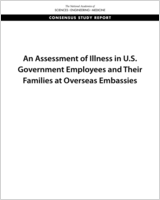NCBI Bookshelf. A service of the National Library of Medicine, National Institutes of Health.
National Academies of Sciences, Engineering, and Medicine; Division on Engineering and Physical Sciences; Health and Medicine Division; Standing Committee to Advise the Department of State on Unexplained Health Effects on U.S. Government Employees and Their Families at Overseas Embassies; Pavlin JA, Relman DA, editors. An Assessment of Illness in U.S. Government Employees and Their Families at Overseas Embassies. Washington (DC): National Academies Press (US); 2020 Dec 5.

An Assessment of Illness in U.S. Government Employees and Their Families at Overseas Embassies.
Show detailsThe National Academies of Sciences, Engineering, and Medicine assembled a 19-member committee with expertise in clinical medicine to include neurology, neuroophthalmology, audiologic, and vestibular medicine, psychiatry, infectious diseases, and rehabilitative medicine, along with experts in epidemiology, environmental science and engineering, toxicology, neurobiology, neuroradiology, health effects of electromagnetic radiation and microwaves, exposure and risk assessment, and health monitoring. The committee members’ biographical sketches are included in Appendix A.
The committee held two in-person meetings (December 18-19, 2019; February 24-25, 2020) and one virtual meeting (May 11-13, 2020); each of them included public sessions with external experts (see Appendix B). The committee reviewed the clinical data about the U.S. Embassy personnel published by clinical teams from the University of Miami (referred to here as “Miami”) (Hoffer et al., 2019) and the University of Pennsylvania (referred to here as “Penn”) (Swanson et al., 2018), as well as information about the U.S. Embassy personnel presented by Miami and Penn, as well as a clinical team from the National Institutes of Health (NIH) during the committee’s meetings. During the February 2020 meeting, the committee heard from experts on the health effects of exposures to chemicals and to directed radio frequency (RF) energy. During the May 2020 meeting, the committee heard from three experts in the fields of mild traumatic brain injury (mTBI), and vestibular and cognitive rehabilitation.
During a closed session at each of the two in-person meetings, the committee met with former U.S. Embassy personnel from Cuba and China, who suffered from some of the clinical manifestations that are the subject of this report, and who volunteered to speak with the committee about their own cases. In order to protect their privacy and their personal health information, the committee omitted details from this report that might enable identification of these individuals.
The committee also reviewed studies of patients associated with the Canadian Embassy in Havana, published and presented by investigators from Dalhousie University in Halifax, Nova Scotia (referred to here as “Dalhousie”) (Friedman et al., 2019).
The committee acquired access to the final report of the CUBA Unexplained Events Investigation conducted by the Centers for Disease Control and Prevention (CDC) on the U.S. Embassy Havana patients near the end of this study.2 It is referred to here as “the CDC Report.”
Throughout the course of this study, the committee received information from DOS that was germane to its tasks, and had multiple opportunities to speak directly with current DOS employees within the Bureau of Medical Services. For this, the committee is appreciative. The committee approached its reporting task by determining the topics and issues on which it felt sufficiently informed to be able to offer findings and conclusions, given the information provided to it. The committee then considered recommendations, supported by these findings, which might assist DOS in understanding and managing these cases, as well as in managing potential future health events. The committee also reviewed the information through the lens of established procedures for investigating clusters of unknown health events (see Box 2). These procedures, among other things, emphasize the importance of standardized data collection.
BOX 2
Steps for Investigating Clusters of Health Events (CDC, 1990).
It is the committee’s view that the information made available to the committee on DOS patients from China is too sparse and fragmentary to be able to draw any substantive conclusions about these cases and their relationship to the cases from U.S. Embassy Havana. The committee’s report therefore focuses on the personnel associated with the U.S. Embassy in Havana.
Of note, from a systems perspective, each agency and organization that has reviewed these cases during the past several years has had available to them different sets of data. There are myriad reasons, including different institutional responsibilities, approaches, investigative tools, timing of investigation, and access to classified information. Although the committee did not have the benefit of data and investigative tools that were available to others, the study may have benefitted from information that either was not obtained by others or was not available at the time that other investigations took place. As a result, experienced investigators from different organizations logically may reach different conclusions based on their own data sources and limitations.
REFERENCES
- CDC (Centers for Disease Control and Prevention). Guidelines for investigating clusters of health events. Morbidity and Mortality Weekly Report. 1990;29(RR-11):1–16.
- Friedman A, Calkin C, Bowen C. Havana syndrome: Neuroanatomical and neurofunctional assessment in acquired brain injury due to unknown etiology. 2019. [July 7, 2020]. https://www
.scribd.com /document/426438895 /Etude-du-Centre-de-traitement-des-lesions-cerebrales-de-l-Universite-de-Dalhousie#download. - Hoffer ME, Levin BE, Snapp H, Buskirk J, Balaban C. Acute findings in an acquired neurosensory dysfunction. Laryngoscope Investigative Otolaryngology. 2019;4(1):124–131.
- Swanson RL 2nd, Hampton S, Green-McKenzie J, Diaz-Arrastia R, Grady MS, Verma R, Biester R, Duda D, Wolf RL, Smith DH. Neurological manifestations among US government personnel reporting directional audible and sensory phenomena in Havana, Cuba. JAMA. 2018;319(11):1125–1133.
Footnotes
- 2
Centers for Disease Control and Prevention. 2019. Cuba unexplained events investigation - final report. Received by the committee on April 28, 2020.
- Methods and Data - An Assessment of Illness in U.S. Government Employees and The...Methods and Data - An Assessment of Illness in U.S. Government Employees and Their Families at Overseas Embassies
Your browsing activity is empty.
Activity recording is turned off.
See more...